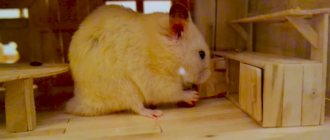- home
- Acquisition
14.04.2018
It is not uncommon for pet lovers to own several pets of different species. Often there are a hamster and a cat in the same apartment. Is such a neighborhood possible? Will it turn into war? Let's sort things out in order.
Can a cat eat a hamster?
Cats are affectionate and kind pets, but they have a hunter's instinct. A running little hamster will not leave any cat indifferent. And its subsequent fate directly depends on the character and upbringing of the pet.
The greatest danger to hamsters is street cats. Their main food is rodents. And it doesn’t matter that the kitten was brought into the house very young and never went outside. With a high degree of probability, the hunting instinct will awaken in him. Such a tandem of a cat and a hamster will end fatally for the latter.
Important! If a cat ate a hamster, there is no point in scolding it. It is not her fault.
Mischievous cats pose no less of a danger to a hamster. This group of pets may not know the street at all. Their hunting is associated with pampering and entertainment. Even a few minutes without supervision can be fatal for a hamster. In this case, cats will not eat the rodent, but they can mortally wound it.
There are also peace-loving cats without a hunting instinct. They are not familiar with the feeling of hunger and the need to obtain food. Pedigree and some street animals have this temperament. In this case, a cat and a hamster can live in the same apartment. They will even sleep and play together.
This applies to Persians, British and other calm, lazy breeds. Bengal, Siamese, and Abyssinian cats are distinguished by their willfulness and pronounced hunting instincts. These will not tolerate potential prey near them.
If a kitten ends up in a house where there is already a rat or hamster, the chances of living together will be quite good. In this case, he considers the rodent to be the owner of the house. May show interest and watch the hamster. But it won't harm him.
How to help a rodent recover from playing with a cat?
But if a dwarf is in the paws of a pet, this does not mean that the cat killed the hamster. The small pet should be removed immediately and the damage inspected. Any wounds from a cat's claws or teeth can be dangerous due to the risk of infection. In addition, the rodent can get sick due to the resulting stress. In such cases it is important:
The small rodent must be protected from contact with the cat.
- Treat wounds with an antiseptic, preferably as painless as possible.
- Take your pet to the veterinarian.
- Create a calm environment for your pet to relieve stress.
- Isolate the hamster.
Djungarik may not recover due to his wounds and repeated stress. Usually, after such incidents, rodents become restless, too mobile and cannot calm down. Veterinarians note that not only small Djungarians suffer from stress, but also large Syrians. They, like purrs, can also have a heart attack from a sense of danger.
What to do if a cat bites a hamster
During hunting or active play, cats can bite a hamster. It is better to avoid such a situation. But if it does happen, it is recommended to immediately treat the bite sites. Any antiseptic can be used for this. Next, it is better to show the rodent to a veterinarian. And upon arrival home, provide him with a calm and safe environment.
Important! After providing first aid, it is not recommended to self-medicate. Wrong actions lead to irreversible consequences.
There are also opposite situations - hamsters bite a cat. First aid will be similar. An effective way to keep neither option open is to keep each other separate.
And now the cons
Here's what a future hamster owner should be prepared for:
Sleeps during the day, makes noise at night
The hamster is a predominantly nocturnal animal. This means that in the dark he will actively run around the cage and make noise, and spend most of the day sleeping in his house. Because of these features, you should not place a cage with a hamster in a room that is used for sleeping at night, and it is not advisable to wake up the animal during the day, even if you really want to communicate with it.
This behavior of an animal is dictated by instincts, and it is inhumane to make adjustments to it by forcibly changing its daily routine. The inability to get a good night's sleep has a negative impact on his health and mood.
The owner is not the owner
The hamster's intelligence and emotional sphere are much less developed than those of cats, dogs, parrots and even rabbits. This means that you cannot expect complex emotional reactions and tender affection from the animal, or arrange fun games with it.
If you leave the cage door open, the hamster will probably run away and you will have to search for it for a long time, turning over all the furniture in the apartment. He will not respond to his owner’s call; rather, he will make a “burrow” for himself in the most inaccessible corner of the house, and after 3-4 weeks he will go completely wild.
Gnawing is life
A hamster is a rodent. Its front teeth are constantly growing, so the animal actively grinds them down on all available objects. Therefore, you will have to periodically change all the wooden and plastic elements installed in his cage. And while walking, you need to carefully watch so that he does not chew the wires or spoil the upholstery of upholstered furniture and your clothes with his teeth.
Short life
These rodents do not live long: the maximum lifespan of a Syrian hamster is 6 years, and the age of a Djungarian hamster rarely exceeds 18 months. If you plan to get an animal for a child, you need to be prepared in the event of the pet’s imminent death to console the baby by choosing the appropriate words.
Is it possible to make friends with pets?
Friendship between different species of animals is a rare and amazing phenomenon. You can never predict how this or that tandem will end. Hamsters and cats can live together. The only way to make them friends is to introduce them at an early age. A 1.5–2 month old kitten is small and defenseless and cannot harm a rodent. On the contrary, these animals will play with interest. But here, too, the breed and temperament of the kitten plays a big role. Not in every case it will be possible to get along together.
Important! When a cat is aggressive towards a rodent, the owner can give it a light click on the nose. Thanks to regular repetition, the cat will learn the lesson.
A hamster and a cat are able to build relationships on their own. However, the owner must be nearby at all times. After all, the older the cat is, the harder it will be for her to get along with the rodent.
You can also try following a certain sequence:
- Pick up the cat and bring it to the cage with the rodent.
- Pay attention to your pet's reaction and prevent her from grabbing the hamster.
- Carefully remove the rodent from the cage and slowly bring it to the predator.
- Hold the hamster tightly. If he becomes afraid, put him back in the cage. When frightened, it can escape from your hands, and only then will the cat’s hunting instincts kick in.
- Repeat the dating attempt several times.
If a hamster and a cat cannot coexist together, hopes for their friendship should be abandoned. It is extremely rare for adult animals to get along with another species.
Will a kitten and a young hamster get along together?
Imagine a situation: you have a cage with a hamster at home, and you bring a small kitten into your apartment. At the first moment, the rodent will arouse genuine interest in the kitten. He can sit by the cage for hours, observing the behavior of the hamster, but he will not take him seriously.
As the kitten grows up, it will begin to get used to the hamster more and more and will gradually stop paying attention to it. The smell of a rodent and its presence surrounded the cat from the very first minute of settling in your apartment. But it’s still better not to leave animals alone!
How to ensure a safe neighborhood
You can create a safe and comfortable atmosphere at home if you follow some rules:
- A secure lock on the door will protect the rodent. The cat will show interest in him and use his paws to open cages with easy locks.
- Feed pets in different places. The hamster should only eat from its own bowl. Otherwise, this will lead to dissatisfaction with the cat.
- Regular communication with the cat, feeding treats and demonstrating love will prevent the appearance of jealousy towards the small rodent.
- It is better to place the cage with the rodent away from the cat’s resting or feeding area. This also applies to the choice of the height of its placement.
- Do not scold the cat for displaying instincts over which it is powerless.
A cat and a hamster in the same house is a dangerous neighborhood. Even friendly and peaceful predators can accidentally harm small rodents. Special attention should be paid to organizing their safe life. And the communication of these animals without supervision should be kept to a minimum.
Unpreparedness for motherhood
Also, one of the possible reasons why hamsters eat their children is the hamster’s unpreparedness for motherhood.
This is especially common during the first birth. The young hamster does not yet feel ready for childbirth and motherhood. This causes her a lot of stress and can have the unfortunate result that she will eat her young. Interestingly, this usually does not happen during subsequent pregnancies and childbirths. If the female refuses the cubs, you can try to feed them yourself. But you need to look at things realistically and understand that this is a very labor-intensive process that takes a lot of time. Hamsters are fed using a syringe, of course without a needle, or with a pipette
The most important thing is to feed the cubs every 2-4 hours! Are you ready to say goodbye to your usual way of life for three weeks and devote all your time to your kids? You decide
Search strategy
How to find a hamster in an apartment, using knowledge about some of the habits and habits of these animals? For example, it is known that hamsters are nocturnal animals, that is, at this time their activity increases. If you haven't found it before evening, don't get upset. Most likely, closer to midnight, people will start running around the apartment and then you can quickly notice the loss. But be careful with the rest of the family - don’t accidentally step on the animal. Use a bait trap. Place a few sunflower seeds in some corners of your home - and the rodent will not keep you waiting. If you don't take him by surprise, you'll at least have a rough idea of where the pet is hiding. Of course, if the loss of seeds is not the work of hungry household members.
Or you can be even more cunning - sprinkle the floor around the piles of seeds with flour or starch. Then the white footprints will lead you to the shelter of the lost homa. Another method to find it is to lay foil or other “rustling” material on the floor in the area of the intended hiding places. At night, hide nearby and listen to the surrounding sounds, trying not to make unnecessary movements.
It is necessary to start the search as early as possible in order to avoid injury or death of the homa, because, having climbed somewhere, the animal may get stuck. First, check out the most popular places:
- around the cell;
- under armchairs, sofa, bed, etc.;
- Inspect the boxes, dresser or closet drawers.
If you do not find a fugitive in these places, do not be upset and adhere to these rules:
- Hamsters are active at night; most likely, with the onset of darkness, they will begin to become active, which will help to detect the rodent.
- Leave a crunchy treat in each room (on the floor), the animal will definitely get hungry and, taking the treat, will give itself away;
- Take flour or starch - sprinkle it in front of the entrances to the rooms and in the center of each room. Having poured it in the center of the room, you need to put the goodies in the middle, taking the treat and going back to a secluded place, the hamster will leave behind its paws stained with flour, this will make it easy to detect.
- Instead of flour and starch, you can spread foil or rustling bags in the same places, be sure to put a treat on them: thanks to this method, you will hear rustling noises when the homa comes out of its hiding place for a treat.
- Place your pet's cage on the floor; most likely, after he has had a walk, he will return to his home on his own. Your task is to pour fresh water, add food and leave the doors open. The animal, having heard its native smells, will want to return to its safe home.
- If your homa's home is not a cage, but an aquarium, place it on its side, following the same principle as in the previous paragraph.











